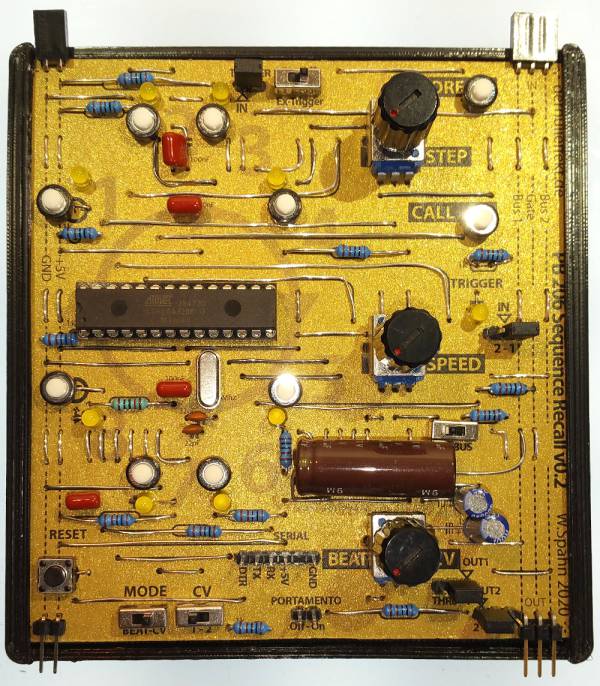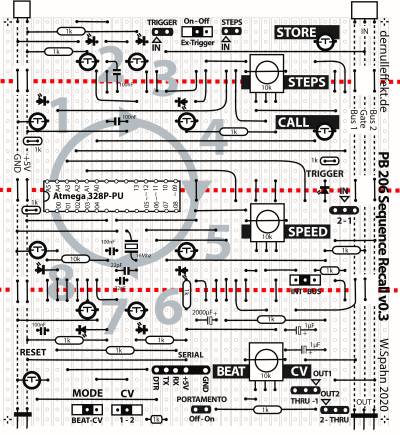PB206 Sequence (Total) Recall
That is again the latest 8 step sequencer for the Paper Bits. This version of the sequencer can store the sequences in the chip's EEPROM and one could call them again after rebooting the device. One can also change steps, speed and the value of two independent CV output. As it has an external trigger input one can easily synchronize it with an other sequencer.
Manual
Assigning CV
Set the MODE switch to CV.
To change the output for each step one select a value with the BEAT/CV potentiometer and in pressing the button for a specific step the selected voltage will be assigned to that step.
Depending on the selection of the CV switch it will be independently stored for the output 1 or 2.
Rhythm
Set the MODE switch to BEAT. Now one can change the length of each step. One can select a value by rotating the BEAT/CV potentiometer and in pressing the button at a specific step the selected value will be assigned to that step.
It just will work if the Ex-Trigger switch is OFF.
Steps
To change between 2 and 8 steps one can use the STEP potentiometer.
If one select 1 step the Sync Sequencer goes into the 1 STEP MODE. By rotating the SPEED potentiometer one can now move to each individual step. That makes it much easy to program the sequencer.
When the STEP jumper is removed one can connect an external voltage source at the IN pin to voltage control the amount of steps.
Change the Speed
The speed of the sequencer can be changed with the SPEED potentiometer or with an external control voltage. For the external control the EX-SPEED switch has to be on ON and with a jumper one can choose if the voltage source coming from BUS 1 or BUS 2.
If the Sequencer is in the STEP 1 MODE one can change the active steps with the control voltage, too.
External Trigger
If one wants to use an external trigger signal one has to set the Ex-Trigger switch on ON. If the TRIGGER jumper is set the trigger signal will come from the GATE BUS. If the jumper is not set then one can use the pin marked with IN for a trigger signal input.
Store and Call
One can store the pattern in 8 differet banks. CV1, CV2, BEAT and TRIGGER values will be stored at once. One can do so by pressing first the STORE button and then one of the STEP buttons, every STEP is one of the 8 banks. The values will be stored in the assigned bank even when the sequencer is turned off. All 8 different pattern can be called by pressing first the CALL button and then the specific STEP button for the chosen bank.
Paper-PCB
Parts
- Resistors:
- 1x 10 kOhm
- 15x 1 kOhm
- Capacitors:
- 2x 22 pF (ceramic)
- 6x 100 nF (foil)
- Electrolytic Capacitors:
- 1x 1µF
- 1x 2200µF
- Diodes:
- 9x LEDs 3mm
- Crystal:
- 1x 16 Mhz
- IC:
- Atmega328P-PU (with Arduino Bootloader)
- Mechanical:
- 1x 28pin IC socket
- 1x pin strip 1×6 (pin two has to be removed)
- 3x pin strip 1×2
- 3x pin strip 1×3
- 2x pin header, female 90° 1×3, 1×2
- 2x pin header, male 90° 1×3, 1×2
- 11x push buttons (2 pins)
- 4x mini switch (3x with one pin cut!)
- 6x jumpers
- Potentiometers:
- 3x 10k
Software
Once you're board is ready, you will need to burn the Arduino UNO bootloader on the Atmega328 chip. Certainly there is no need to burn if you are lucky and have one of those chips with a preinstalled bootloader. If not follow the instructions to burn the bootloader here:
burn the bootloader
Insert the chip into the IC socket and connect it to you're computer using a USB to Serial board. For example one like these: Arduino USB Serial or Sparkfun Breakout Board . Or use your Arduino as a Serial Adapter
Open the Arduino IDE software on your computer and upload the following code to the board (Arduino UNO):
pb206_sequencerrecall_01.zip
Here is a manual for using a USB Serial with the Arduino Pro Mini - uploading code to the sequencer is similar: https://www.arduino.cc/en/Guide/ArduinoProMini
… and voila ready for the total step!
License
The PB206 Sequence (Total) Recall was designed by Wolfgang Spahn, 2020.
It is licensed under a Creative Commons Attribution-NonCommercial-ShareAlike 4.0 International License.


